
(Basic Geometry of Cognitive Activity)
Point- Line- Plane
| RSP 1 | RSP 2 | RSP 3 | RSP 4 | RSP 5 | RSP 6 | RSP 7 |
Lookiloos as of August 4th, 2025
The reference to a namelessness entity or element is a recurring cognitive item found in multiple variations and contexts. Even though all the words in a triple pattern are names, and the names are used for separate identities and kinship within a given set-of-three, the inter-connectedness with other threes is not routinely mentioned nor brought together as a family or tribal gathering. By bringing the different ideas together and suggesting we might well establish a rule-of-thumb for distinguishing similarities, as if we have somehow begun to unlock a type of code to unravel an aspect of cognitive activity that has gone overlooked... and in so doing, we've begun to establish a formal means of unlocking as aspect of thinking which spans multiple centuries... andy yet, will it develop further as we begin to recognize its traits?
Names and naming can be useful, but also hinder perceptions interpretations as well as communication. From stories such as Rumplestitskin we can derive some inkling that the naming of an object or person somehow translates into having power over it and them, the words/labels/names being used to describe elements in a trio such as the rock- scissors- paper ensemble, if taken literally, do not permit a person to easily identify similarities, connections, correspondences with other ideas expressed in a triple form, unless some interconnecting formula is attempted that has not been tried before, and does not rely on the conventions of established subjects which are used to bolster the subject matter of a given subject such as using religion to interpret everything so as to promote religion, or the use of some other subject matter in order to pronounce it as being more special than other subjects where dichotomous ideas such as superior/inferior, stronger/weaker, richer/poorer, etc., are commonalities.
From the internet using the query "what's in a name?", the following reply is rendered:
The phrase "What's in a name?" from Shakespeare's Romeo and Juliet suggests that a name is just a label, and the essence of something or someone is not defined by it. While a rose would smell just as sweet regardless of its name, names can hold deeper significance, representing identity, culture, and even aspirations. Here's a more detailed breakdown:
- Shakespeare's View:
- Juliet's famous line, "What's in a name? That which we call a rose by any other name would smell as sweet," implies that names are arbitrary and don't change the inherent nature of a thing.
- Beyond Labels:
- However, names can also be powerful markers of identity and cultural heritage. They can reflect a person's family history, background, and even influence how they are perceived by others, according to an article on Medium.
- Personal Significance:
- Names can be deeply personal, carrying stories, traditions, and aspirations. They can connect individuals to their past, their family, and their community.
- Cultural Context:
- In some cultures, names are chosen to reflect specific qualities, circumstances of birth, or aspirations for the future. They can also be part of a kinship system that defines relationships and social roles.
- Modern Perspective:
- Today, the question of "What's in a name?" continues to be relevant. Names can be chosen, changed, or adapted, reflecting personal journeys and evolving identities. They can also be a source of pride, connection, or even a source of struggle when faced with micro-aggressions or misunderstandings.
Examples of Sources:
- What's in a Name? by Afrah A. Ali
- What’s In A Name? Perhaps A Great Deal! by Rabbi Brad Hirschfield
- What's in a Name? by Chris Haugh
We are looking at what appears to be different renditions of a conceptual framework that has been held over from a distant past. There is no consistent attempt to create a more-than-three cognitive pattern by humans or Nature. To do so, we would have to be on an other-than-third planet; have a non-triple family lineup in particle physics, and a non-triple code in our DNA. Whereas we can develop a culture which organizes its social structure and practices in accord with some pattern such as four, like a Native American tribe, yet this does not change the facts of nature. Attempts to claim some measured "fourness" can routinely be viewed in multiple cases as a 3:1 ratio. With the colon symbolically referencing the word to, with, from, etc... For example, nature doesn't claim a quadruplet code for DNA and RNA, it provides for a 3 to 1 ratio in the form of three the-same amino acids (Adenosine- Cytosine- Guanine) with a single separate identity of Thymine and Uracil. In terms of dimensions, again we see a 3 to 1 ration in terms of 3 spatial to 1 time. The same goes for matter. We have three standard forms of matter on Earth (solids- liquids- gases) and 1 form of matter prevalent off the planet called plasma. With respect to proteins, there are 4 stated structures which can be individually assigned:
- Primary (amino acid sequence) is a bead structure.
- Secondary (local alpha-helices and beta-sheets) is one of 3 common ribbon structures.
- Tertiary (overall 3D shape of a single polypeptide chain). This is another type of ribbon structure.
- Quaternary (arrangement of multiple polypeptide chains) is a ribbon structure.
However, they can also be described as a 3 to 1 ratio:
- Primary structure is bead-like.
- Secondary- Tertiary- Quaternary structures as ribbon-like.
- The "beads on a string" model represents the primary sequence of amino acids, while ribbon diagrams depict the secondary structures (alpha-helices, beta-sheets, and loops/turns) that emerge from the local folding of the polypeptide chain.
Yes, we can describe the compartmentalizations as a "four" and think we have surpassed the regularity of the "three" recurrence, or we can instead see it as a ratio that also is identifiable in the four gospels and four horses of the Apocalypse, as will be noted later:
- The three Synoptic Gospels are Matthew, Mark, and Luke. These Gospels are grouped together because they share a high degree of similarity in their content, structure, and wording, allowing them to be viewed together, or "synoptic". The gospel of John is viewed as idiosyncratic because of its dissimilarity with the other three.
- Three of the four horseman of the Apocalypse represent torments for humanity, but only the fourth horseman represents actual and definitive death.
- Value notation in mathematics sets three together (ones-tens-hundreds) separated by a comma before the 4th (thousands etc.) is added. In other words, sets of three divided by commas.
- Etc: 3 to 1 ratios.
Another example of the flip-flopping tripartite expression can be seen in the lineup of level types, that I have put in order according to the one- two- many theme:
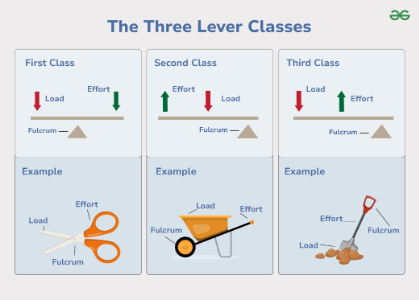 This is the typical lineup |
 This lineup advances a 1-2-many theme |
Along with the "Rock- Scissors- Paper" trio, the (already mentioned) basic tripartite geometric order of "Point- Line- Plane" and the common utensil expression of "Knife- Fork- Spoon" can easily be deduced as representative symbolisms of humanity's early counting efforts at establishing the first three quantitative measures widely known as One- Two- Many.
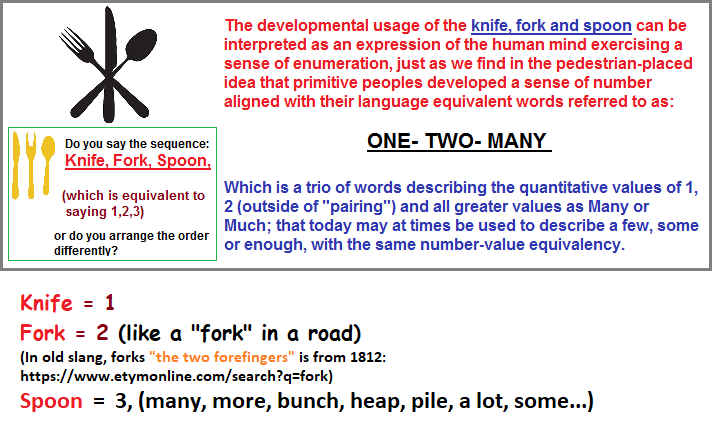
Granted the earlier attempts may have sported an initial one-word "one" followed by a two-word "One-Many" extentiveness that was later replaced by a three-word "One- Two- Many", the three-word phrase will suffice for the duration of the present discussions. It is of need to look a bit more closely at this idea by providing information culled by way of the query "one two many counting word limit"
The "one, two, many" counting system refers to languages where speakers have distinct words for "one" and "two," but then use a single word to represent quantities beyond that, often translated as "many." This system has been observed in some cultures, notably the Pirahã people of the Amazon. Research suggests that the Pirahã's "one" and "two" are more about relative quantities than precise numbers, and their "many" doesn't necessarily denote a large quantity but rather "a quantity that is not one or two". Here's a more detailed explanation:
- Limited Counting Systems:
- Some languages, like Pirahã, have a very limited set of words for numbers, typically just "one," "two," and "many".
- Beyond Two:
- Instead of having separate words for each number beyond two, these languages use a single term to represent quantities greater than two.
- Relative vs. Absolute:
- Studies suggest that these words aren't necessarily precise numerical terms. For example, the Pirahã word for "two" might be used for quantities up to five or six, and their word for "one" for quantities up to four.
- Cognitive Implications:
- This system raises questions about how language influences numerical cognition and how humans develop numerical concepts.
- Pirahã Example:
- The Pirahã language is a prime example, with researchers observing that their counting system doesn't function like our standard numerical system.
- "Many" is Not Always "Many":
- The Pirahã word translated as "many" doesn't necessarily mean a large quantity but rather a quantity that is not one or two.
- "One, two, many" is not a universal stage:
- While some cultures might have started with "one, two, many," it's not a universal stage in the development of all counting systems.
Other sources for development of numbers/counting (I have read):
- The Universal History of Numbers: From Prehistory to the Invention of the Computer 1st Edition by Georges Ifrah
- Number Words and Number Symbols: A Cultural History of Numbers by Menninger, Karl
It is not that human imagination nor Nature can not exceed the "3", but that the deteriorating effects of the Earth and its triplex system represent a constraint expressed in terms of a repetitive 3 part system, whether we use 1-2-3, x-y-z, father-son-spirit, three strikes you're out, three families of fundamental particles, three geometries to the Universe, etc... Yes, there are instances when a more-than-three compartmentalization is used by human conceptualization and Nature, such as the notion of some spectrum, but we do so in step with a larger currency of tripartite groupings such as patterns-of- one-two-three, 2-3-4, [7 + or - 2: (5-7-9)], monalities (as "1")- dualities (as "2")- pluralities (as "3", 3rd, more than 3...), some of which are described as a foursome but would be better expressed as a 3-to-1 ratio, or a fivesome better expressed as a 3-to-2 ratio.... Because life is a group of activity related to Earth's changing rotation rate and thus express rotation rate specificities; the ongoing incremental deterioration of the rotation rate is having an incremental effect on the survival rate and type of life to be sustained.
It stands to reason that if Nature uses a recurrence of patterns -of- three, sometimes incorporating other patterns; whereas we see a recurring "three" scenario in particle physics, biology, genetics and anatomy, it should be no wonder that the human mind would likewise be predisposed to exhibit this same pattern in different ways, different languages, different eras, different subjects, etc... It is unfortunate that some people think that to use a pattern-of-four expression while others are using a pattern-of-three, they think they are superior, and yet four and more are part of the old 3rd place plurality theme used by those in the deep past who participated in the development of a counting system. Indeed, the notion of plurality appears to have been a primary form of recognition and practice orientation such that we find practices of plural god figures such as the described pantheons preceded by the spirit/ghost/shadow pluralities inherent with animistic (and other early) orientations, prior to the use of pairs, triads, and one god concepts. Indeed, they give the impression of being pictograph models of early counting attempts to describe occurrences in nature which are little different to the words we use to describe different quantities of animals:
- Flock of birds
- Pride of lions
- Pack of wolves
- School of fish
- Gaggle of geese
- Congress of baboons
- Swarm of bees
- Herd of horses
- Murder of crows
- Army of ants
- Bed of clams
- Brace of ducks
- Class of students
- Theater of armed conflict
- etc...
Just because you and most people don't recognize the underlying numerically associated cognitive attributes of the "Rock- Scissors- Paper" elements and those of other tripartite organized themes, doesn't meant that the recognition of a subtle reference to enumeration is false. Typically, some word or symbol or even gesture is used to describe a situational count of more than two with a word or symbol that is not a number. It's not that we can't count out the exact quantity of horsed in a herd, we simply condense and symbolize and accept the generality as if it were somehow an acceptable definitive for conversational purposes, though an exact number is needed if you are buying and selling them. Commerce tends to make counting more definitive in multiple cases. In some instances a trio like the rocks- sissors- paper is an illustrated counting expression that the brain exercises but the mind in the present era does not hear the count. The human brain is talking but educational systems around the world have not taught the human mind how to listen nor human eyes how to see very well. 22nd century education standards are in an appreciable state of ignorance.
In some instances you will be able to see multiple models of correlative similarity, while others require a stretch of the information due to origin, originator, and origination influences. Sometimes numerical, sometime ideological, and sometimes some barely visible connection, while at other times there doesn't seem to be any except for the overall usage of a three-pattern. Concentrating on one repeating pattern may cause you to overlook one or more others with a larger application. Apparently we are all prone to becoming distracted by minutia at one time or another.
In an analogical Primitive sense of association, Translating the trio of "Rock- Scissors- Paper" into numerical values, we have the "1" rock, "2" fingers, and because the primitive attempts by early humans at counting did not have explicit values beyond the "2"... and is frequently described with the generic reference as a "1- 2- Many" counting scheme, a modern observer offering the value of "5" for the open hand is much too modern and sophisticated when illustrating a basic thinking (mental, cognitive) theme. The word "many" can alternatively be described as much, more, all, heap, pile, etc... In other words, our usage of the word "many" describes what a primitive mind may well have used, in their relative expressions (language, symbols...) to represent the notion of everything else beyond the "one" and "paired" association. In other words, the present day usage of the word "many" speaks to the value of "covering" all quantities beyond the 1 and 2. The sequence of "1- 2- Many" appears to be an overlapping gradient.
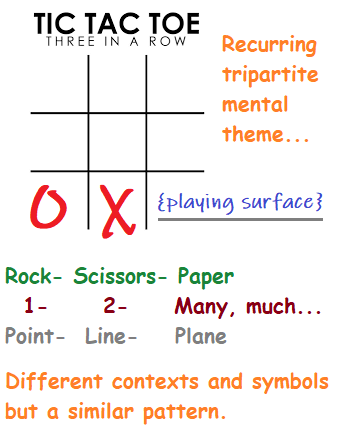
While looking at other tripartite ideas, both in, out and alongside gaming applications, the U.S.A. commonality of "Tic- Tac- Toe" game to mind, though it is called by other names in different countries, noting that the Three Men's Morris game is thought by some to be a precursor development form:
- United States: Tic-Tac-Toe
- England: Noughts and crosses
- Canada & Ireland: Xs and Os
- Spain: Tres en raya or Gato ("Gato" means cat)
- Peru: Michi (michi means "cat")
- Netherlands: Boter, kaas en eieren (Butter, cheese, and eggs)
- Poland: Kólko i krzyzyk (Circle and a cross)
- Denmark: Kryds & Bolle (Cross & Bun)
- Norway: Twiddles and Bears
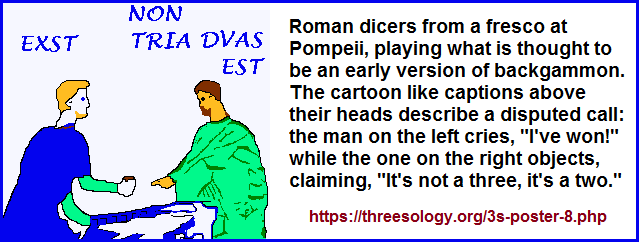
It is a game of strategy with two people using a 3 X 3 (33) [9-squares] grid. {The "2" and "3" have a combination which plays out as a relationship in different instances in various subjects.} While only two elements in the Tic- Tac- Toe variant are visibly used, a third, typically overlooked element positions itself in the minds of players in the form of a position to either avoid or strive for so that a triple pattern can be achieve. In any respect, the USA version also yields three letters of the vowel system with the use of an i- a- o in the second letter position of the words, with an "e" holding the 3rd position of the 3rd word, along with the presence of 1 consonant repeated three times. If one says a-e-i-o-u, the i and a are in a reverse position. However, the version of the game in England references a more honest representation of the elements of "zeroes" and "x's", thus allowing a closer approximation to identifying the symbolic presence of the rock- scissors- paper scheme. The word "nought" for a zero or "o" can be viewed as a rock, the "X" as a type of opened scissors, and surface upon which the game is played is the "paper" or "plane" (or "board").
Other types of "board" games also use two players such as chess and checkers, allowing game pieces to be moved in three alternative directions: Horizontal- Diagonal- Vertical. These attributes, along with the enumerated "64" grid make up part of the numerology used by different researchers who may construct analogical correspondences to other subjects, thinking they are on the conceptual trail of discovering some hidden message by the adopted code they apply and import/export to their respective interest such as use of the "64" tied to some underlying significance involving fractals, charkras, genetics, music theory and philosophy beyond the syllogism... or wherever conceptual grids are evident and can be relativized. Here are some examples:
- Beyond the Woo: The Link Between Astrology, Human Design & Genetics by Bonnie Ornsby
- The Human Genetic Code and I Ching’s 64 Hexagrams by Deyi Wang
- The 64 Yoginis (Awakening The Divine Feminine) by Sujata Nandy
- Chakras and The 64 Yoginis
If we do not use number and instead rely on some model of preformative artistic inclination which may resort to the use of metaphors and analogies of basic geometric forms; some of the following correspondences/correlations are easily understood, while the third placements may need a bit of broadened deductiveness, though the sequence itself reveals greater complexity of organizational attributiveness from beginning to end, just as we see in other maturational or evolutionary treks. For the moment let me recite the widely known child's (English) expression as a rebuttal to someone's belittling accusation: "Sticks and Stones may break my bones but Names will never hurt me." We need only to remove the pluralization (the "s") in order to see the resemblance to the Rock- Scissors- Paper game and the Point- Line- Plane of geometry. However, we can again see a flip-flop arrangement of terms like a shells game or word order, requiring a different alignment:
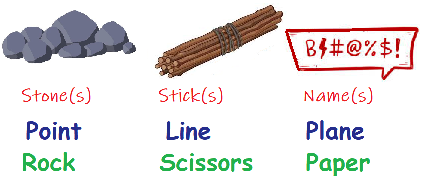
Because we can find multiple Trio references which apparently exhibit an underlying conceptual link to the early counting theme, we must wonder why such a contour of thought remains as a cognitive hold-over and can also be found in the vertebrate characterization called the Pentadactyl Limb, basic atomic structure as well as macro-molecular development, etc...
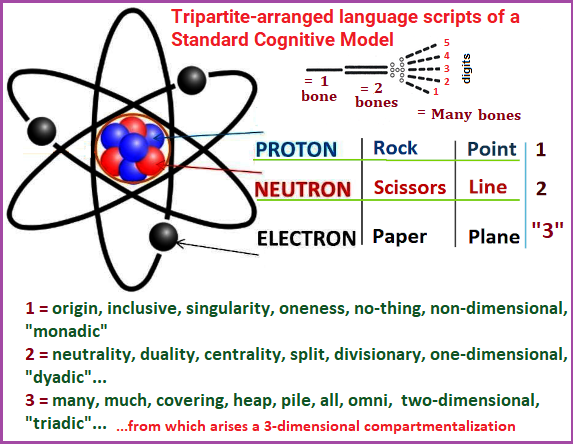
It gives me the impression, after collecting together various tripartite structures under the heading of a basic 1- 2- Many counting theme, what we are looking at is a list of Runic language scripts set in a tripartite fashion suggesting we are paying witness to what might be described as a Standard Cognitive Model. I wonder if this is how Georges Dumezil got started in developing his theory involving all Indo-European cultures, even though his work is described here Georges Dumézil Introduction as a contextually driven orientation instead of a Unversalist approach; and yet requires an overall "universal" appreciation of the many myths that were individually surveyed. All specializations require some level of holistic Unveralization. Whereas Dumezil's work is often described as an illustration of myths occurring in the cultures of Indo-European, it is a wonder why anyone would not characterize this as a type of universality.
Although my ideas may be the state of crude and fledgling seeds, let them be planted in the open air and light of public exposure, if for no other reason than to see what animal eventually evolves from these simple roots. And with evolutionary growth in mind, let me momentary digress to present the origination of the following trio, using the internet query "origin of animals, plants, fungi":
- Animals (3 main feeding types: herbivores, carnivores, and omnivores.)-
- Plants (3 main types: herbs, shrubs, and trees)-
- Fungi (3 main types: mushrooms- molds- yeasts)-
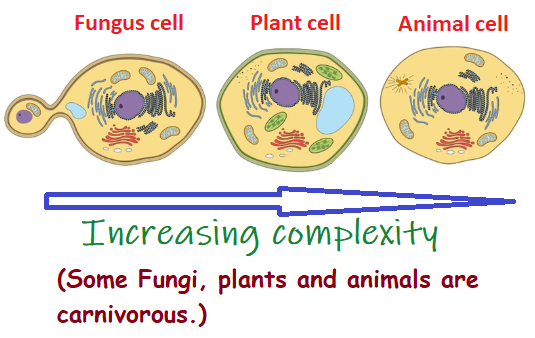
- Carnivorous Fungi: 3 phyla: Ascomycota, Mucoromycotina, and Basidiomycota.
- Carnivorous Plants: Venus flytraps, pitcher plants, sundews, and bladderworts.
- Carnivorous Animals: (Internet query: "examples of carnivorous animals")
- Mammals: Humans, lions, tigers, cheetahs, wolves, bears, and many other mammals are carnivores.
- Predatory ideologies: Business, commerce, education, government/politics, military, police, religion, sports...financial opportunity, sex, social position, etc...
- Birds: Eagles, hawks, owls, and other birds of prey are carnivorous.
- Reptiles: Alligators, crocodiles, snakes, and Komodo dragons are examples of carnivorous reptiles.
- Marine Animals: Sharks, orcas, piranhas, barracudas, tuna, squids, Octopi, cuttle fish, lobsters, and certain cichlids are carnivores.
- Insects: Some insects, like praying mantises, dragonflies, ladybugs, mantids, ground/tiger beetles, assassin Bugs, wasps, lacewings : are also carnivores.
- Mammals: Humans, lions, tigers, cheetahs, wolves, bears, and many other mammals are carnivores.
Animals, plants, and fungi all evolved from a single-celled eukaryotic ancestor, diverging from each other over a billion years ago. Fungi and animals share a more recent common ancestor than either does with plants, with fungi and animals diverging around 1 billion years ago. Plants evolved from a different lineage of single-celled organisms with photosynthetic capabilities.
- Early Eukaryotes:
- All three kingdoms (animals, plants, and fungi) belong to the group of eukaryotic organisms, meaning their cells contain a nucleus and other membrane-bound organelles.
- Opisthokonta:
- Animals and fungi are grouped together in the clade Opisthokonta, named for the rear-facing flagellum present in their common ancestor.
- Divergence:
- The lineage leading to fungi and animals split from other eukaryotes around 1 billion years ago.
- Fungi and animals then diverged from each other around 965 million to 1 billion years ago.
- Plants evolved from a separate lineage of single-celled eukaryotes.
- Fungal Evolution:
- Fungi are characterized by their unique mode of nutrient acquisition (secreting enzymes and absorbing nutrients) and the composition of their cell walls (chitin).
- Plant Evolution:
- Plants evolved from photosynthetic prokaryotes and developed cell walls made of cellulose.
- Animal Evolution:
- Animals, unlike plants and fungi, evolved through a process of gene duplication and fusion, leading to greater genomic complexity and multicellularity.
Page initially created: Sunday, July 20th, 2025... 4:44 AM
Initial posting: Monday, Aug. 4th, 2025... 8:02 AM